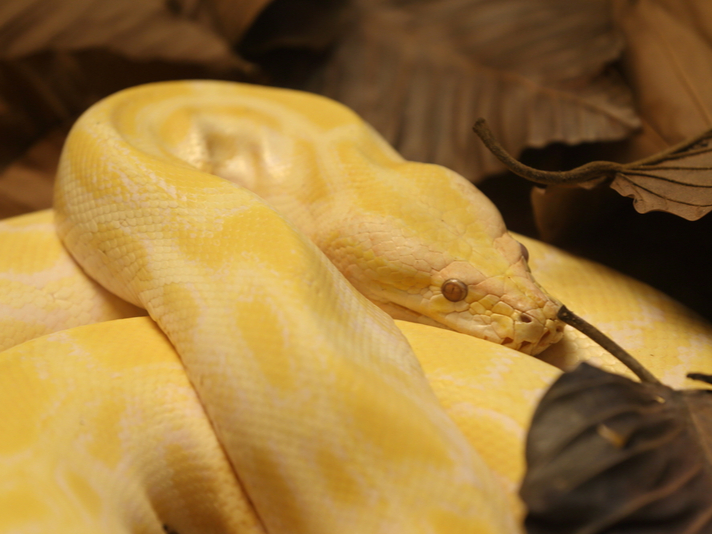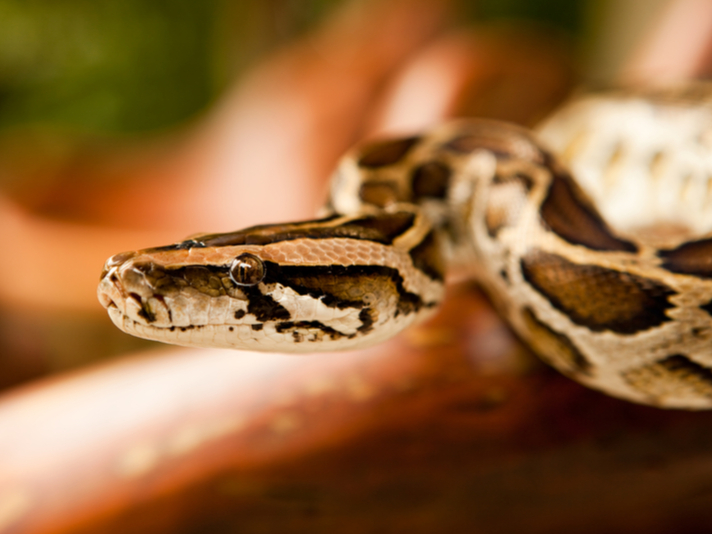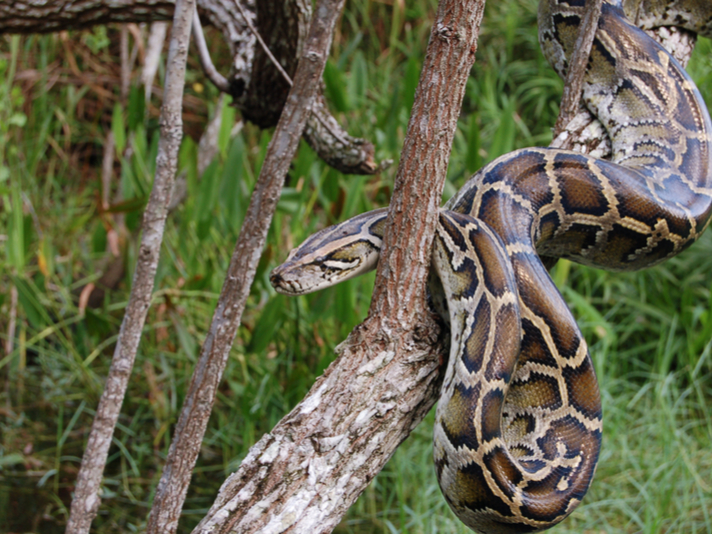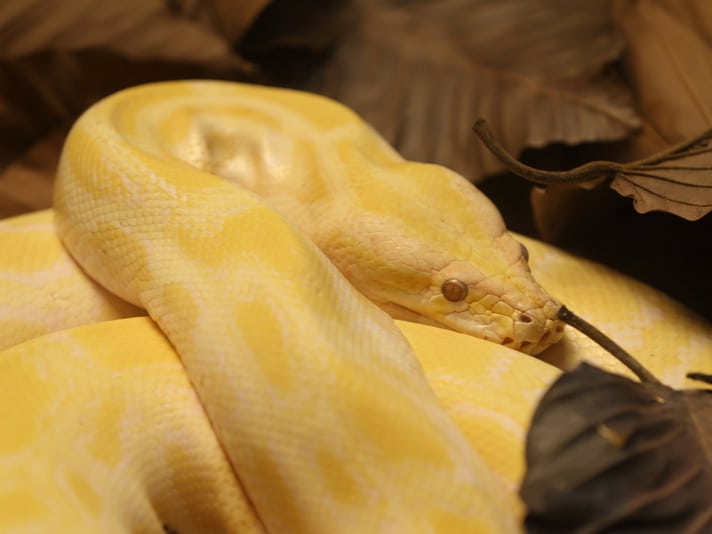The Burmese python has had an interesting existence in the United States.
The girl stood wide-eyed and staring at the 8-foot Burmese python I’d just draped around her neck and across her shoulders. One of her comments above all stuck in my mind and epitomizes the contrasting emotions this snake elicits from people: “The skin is so smooth and beautiful. I suppose those would be funny last words as it was crushing me to death.”

wannasak saetia/Shutterstock
The popularity of Burmese pythons radically increased in the early 1980s, when the first albinos were introduced to herpetoculture.
No worries — she survived. As did hundreds of other paying customers that day who wanted their photos taken while holding our “big, scary snake” in front of our artificial jungle at the mall. Giant snakes have always fascinated people, which is why our photo booth was so popular with passersby. If they’d come upon the same animal in their backyard, the reaction would have no doubt been very different.
Burmese Python in the Pet Hobby
The Indian python (Python molurus molurus) was trickling into the U.S. for both pets and sideshow exhibits during the 1960s and ’70s, until increasing demand raised concerns that landed it on the Endangered Species Act (ESA) in 1973 and the Convention on International Trade in Endangered Species (CITES) in 1975.

lunatic67/Shutterstock
Burmese pythons can, indeed, make great pets for the few people with the ability and facility to care for a snake that can attain a length of 15 to 20 feet.
The resulting shutdown of importation and interstate sales of P. m. molurus focused interest on the darker and larger subspecies known as the Burmese python (P. m. bivittatus), which was being imported from several southeast Asian countries rather than India. Although not usually as calm as the Indian python, the Burmese was still more docile and made a better giant snake pet than other choices, such as the African rock python (P. sebae) or reticulated python (Malayopython reticulatus), wild-caught specimens of which back then were well-known for being irascible.
Burmese pythons can, indeed, make great pets for the few people with the ability and facility to care for a snake that can attain a length of 15 to 20 feet. The stocky little 2-foot hatchlings are the perfect size to appeal to pet reptile keepers. Right out of the egg, they are big enough to eat adult mice, making them easy to feed. Their attractively patterned, silky-smooth skin is also appealing. As they grow, that same skin thickens and toughens, causing its demand in the skin trade. The strongly blotched design definitely passes the “hatband test,” meaning it’s useful and pretty when applied to clothing of all sorts.
Burmese pythons are easy to breed in captivity, too. Females usually lay a couple of dozen eggs per clutch, sometimes up to 60 or even 80, depending on the age and size of the female. Males generally become sexually mature at around 7 feet in length, while females usually take until they’re around 8 to 10 feet. And they keep growing for life. Many owners acquire their pets as 2-foot-long cuties, never suspecting the proportions the snakes are capable of eventually attaining.
The popularity of Burmese pythons radically increased in the early 1980s, when the first albinos were introduced to herpetoculture. The bright yellow and white snakes were, and still are, amazingly beautiful. They seized the attention of the snake-loving public and helped propel the art of snake breeding ahead, due to the monetary value these stunning animals commanded. Small fortunes were made by some of the early albino Burmese python breeders, when prices of $3,000 per snake were being paid. Because the pythons are so prolific, though, the price of the albinos plummeted each year, until they became affordable to anyone who wanted one at roughly $200 apiece by the 2000s. Over the ensuing decade, more pattern and color mutations were discovered and selectively bred, keeping the Burmese python in the herpetocultural limelight.
Although baby pythons can start out a little nippy, they generally calm down very quickly with a minimum of gentle handling. Over the first year, the cute little snakelings usually grow to about 4 or 5 feet, though 8 to 10 feet is possible with excessive feeding. And, within just a few short years, that cute baby has outgrown the abilities of the average keeper to house and care for it properly.
This is where the trouble often begins, because if the baby python was bought as an impulse item, the owner often ends up overwhelmed, with a 15-foot, 150-pound, rabbit-eating critter that needs ever-bigger caging. At this point, many keepers decide their once-cute little snake is outgrowing their ability to house and care for it. This is when such people often receive a shock, when they find out that zoos generally won’t accept donations of this common snake because most have plenty of giant snakes already.
Many herpetological societies work to find homes for these huge, unwanted pets, as do some reptile rescues and sanctuaries, but they’re being overrun, too, and many are forced into turning away any more Burmese pythons. This is why it is imperative that potential pet owners research the needs of this species (or any species) before purchasing one.
The Burmese Python in South Florida
What you’ve read so far might be considered the ancient history of the Burmese python. Unfortunately, it has gone on to make history of a different sort, and still is as your eyeballs roll over these words. The Burmese python is the biggest, bulkiest reptile to ever become an invasive species in the wilds of the U.S. This has left the public mesmerized, as well as fearful. Let’s explore what has happened to make this snake front-page news.

Heiko Kiera/Shutterstock
Burmese pythons certainly don’t belong in Florida wilderness areas, and they undoubtedly have impacted the ecosystem.
Burmese pythons are established and breeding in southern Florida, and have been since at least 1979. They were turning up in the Everglades with increasing frequency during the 1990s, but it wasn’t until a 2005 photo showing a dead python with a 6-foot alligator that had exploded from its belly that things went viral. Everyone was already certain the Everglades was swarming with deadly snakes, but this? I’m sure the prevailing thought ran something like "Do you mean there’s now something big and bad enough out there that it can eat adult alligators?"
The media circus that blossomed around such a sensational image was exactly the kind for which the evening news salivates, and the flames were fanned when anything regarding the pythons in the Everglades was treated as headline news. Experience had long ago taught the media what sells, and the resulting public hysteria helped fuel pressure on the Florida Wildlife Commission (FWC) from state politicians to fix the “problem.”
Coming at the same time as plans and grants to restore the Everglades, this meant that politics had a big role to play — probably more than actual conservation. When there is money to be made, logic and reason is often the first casualty, and Burmese pythons became a hot selling point for any entity looking to increase funding in order to “Save the ‘Glades.” Giant snakes, after all, are a lot more exciting than feral hogs or cats.
An infamous (and flawed) 2011 study, funded by the federal government and embraced and distributed under the auspices of the U.S. Geological Survey, predicted that Burmese pythons would eventually colonize most of the southeastern U.S., from Washington, DC all the way through most of Texas and as far north as San Francisco. The South Florida Water Management District (SFWMD), the governmental agency responsible for protecting water resources by balancing and improving flood control, water supply, water quality and natural systems, used the python’s presence to further plea for more funding. State and federal agencies are always looking for ways to justify their existence, and to have more money allocated to them, so it behooved some to capitalize on the pythons’ presence.
Don’t get me wrong — Burmese pythons certainly don’t belong in Florida wilderness areas, and they undoubtedly have impacted the ecosystem. Besides the alligator from the previously mentioned, now-infamous photo, prey as large as deer and large wading birds have been recorded in the stomachs of the thousands of Burmese pythons that have been captured inside Everglades National Park.
Those intent on demonizing the pythons try to focus attention on the fact that they may prey upon the cute and pretty species park visitors can relate to best. What gets less media coverage are other studies that suggest the snakes appear to be responsible for a decline of small and medium-sized mammals such as raccoons and skunks — animals that have proliferated as beneficiaries of human presence. If true, their culling could have a positive effect by quelling the exploding populations of such mid-range predators that have been contributing toward the dwindling of turtle nests in recent years. There are always both winners and losers any time there is a change in the environment.
You might think the question of how Burmese pythons got established in the Everglades should be old news by now, in the wake of dealing with the actual problem. Certainly they arrived in the U.S. via the pet trade — of that, there is no doubt. But did they spread into the wild intentionally or by accident? This is the issue that persists to plague herp keepers in the form of new laws falling in place to restrict the movement and ownership of many popular boa and python species across the country.
Animal rights groups such as People for the Ethical Treatment of Animals (PETA) and the Humane Society of the United States (HSUS; not to be confused with your local humane societies) would have you think that lines of cars arrive from throughout the U.S. into the Everglades, disgorging pet owners who then dump sacks full of unwanted pet snakes into the national park. In all honesty, it is likely that some owners have dumped pets on at least a few occasions, but the prevailing theory as to how Burmese pythons wound up in the Everglades is that the most likely culprit was 1992’s Hurricane Andrew. Dealers, import facilities and exhibits sustained heavy damage in southeast Florida during that storm, and it has been reported that more than 700 baby pythons disappeared from just one facility that was destroyed.
A 2008 DNA study done by Everglades National Park (ENP) and Florida International University found that the 156 pythons of all sizes that were sampled were closely related. Only four specimens’ genetic profiles suggested they were not of the stock from which all the rest originated. It is logical to assume that the samples might have come from siblings or even a single gravid female, which in turn means that the vast majority of the pythons tested arose from just a single introduction, not from dozens or hundreds of snakes released by pet owners. This paper has not been widely acknowledged, probably because it doesn’t bolster the case of those entities trying desperately to convince the public that “everybody” is still releasing their unwanted pets.
Controlling the Burmese Python in South Florida
The number of Burmese pythons in southern Florida habitat has been estimated at anywhere from tens of thousands to hundreds of thousands. Range maps online show them as being found over most of the state, with records from north of the Everglades consisting almost entirely of random animals that are likely escaped pets. This would be terrifying news for people believing it’s the spread of what may soon become breeding colonies of Burmese pythons.
Python Hunts in South Florida
Florida’s Python Elimination Program Dispatches 500 Snakes in Five Months
Snake Hunter Teams Up With VolAero Drone Start Up To Hunt Pythons In Everglades
Numerous methods of control have been proposed or tried, including limited hunts and contests sponsored by the FWC. These efforts generally turn up a very small number of pythons, much lower than the numbers found by seasoned local python hunters who know how, where, and when to look for them in the field. All pythons collected have been euthanized. Meanwhile, it is not legal for licensed reptile hunters or anyone else (except ENP personnel and biologists) to collect animals inside Everglades National Park boundaries, even invasive species! And, unfortunately for the hoped-for success of these hunts, that is where the greatest numbers of Burmese pythons are found.
In 2012, the federal government banned interstate transportation of Burmese pythons and several other species of big snakes. This means that people living in states that can’t possibly support wild colonies of them are just as legally restricted from taking their pet Burmese pythons with them if they move across state lines as those living in the warmest states. Will all of these new bans and restrictions help stop the invasion? In my opinion, probably not. Instead, it’s more likely Mother Nature will contain the threat.
Two facilities have experimented with keeping a few Burmese pythons outdoors through the winter outside of south Florida. One was in northern Florida, in Gainesville. The snakes were even provided with heated hide boxes into which they could take refuge, but the snakes were not genetically programmed to use them and did not survive the winter. The other facility, in South Carolina, provided a large, outdoor, fenced area with natural shelters such as native snakes would use. All of the pythons there either died or had to be euthanized due to health problems resulting from being outside during the winter. These results, in addition to the common knowledge that Burmese pythons are sensitive to cold (known to everyone who has kept them in captivity for years), prove that Burmese pythons are not able to survive long outside in southern Florida, and they’re certainly unable to colonize areas further north.
Even in the most tropical areas of south Florida, a serious freeze usually occurs every few winters. It has been observed that the populations of common tropical invasive reptiles, such as green iguanas and Burmese pythons, grow quickly over several years with warm winters. But when a freeze occurs, up to 90 percent of many local populations die off, severely beating back the populations. Such freezes will prevent permanent colonies from becoming established in most of the areas on the fear-mongering USGS map. That said, Burmese pythons are in south Florida to stay.
It has been proposed that global warming may eventually extend the snake’s range northward, and that is certainly possible. But if global warming changes are enough to accomplish that, then pythons will probably be the least of our problems. Burmese pythons are essentially a south Florida issue. Total eradication there is now considered to be out of the question, and they’ll be a part of the southern Florida ecology for better or worse. Despite mass demonization, they’re now part of the new ecology, and their presence will probably result in changes on par with the hundreds of other exotics already established and breeding there.
Bill Love is devoted to the pursuit of reptiles as a field herper, photographer, captive breeder, lecturer, eco-tour leader and writer. He travels frequently to speak to groups about these subjects. He can be contacted through his websites BlueChameleon.org and BillLovePhotography.com.


